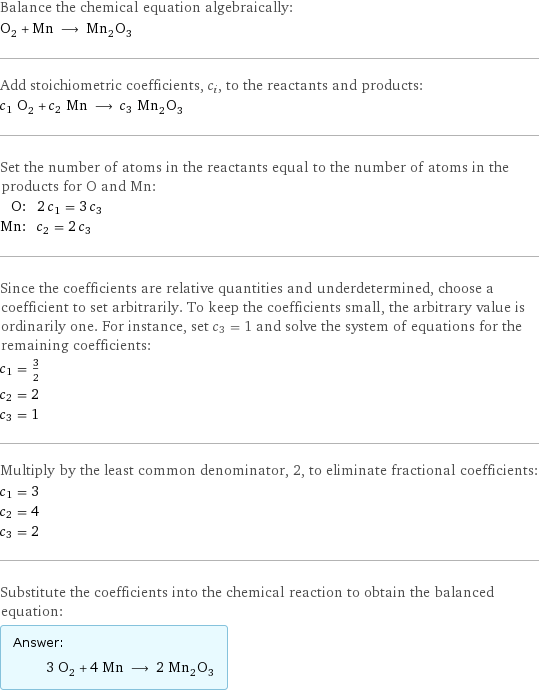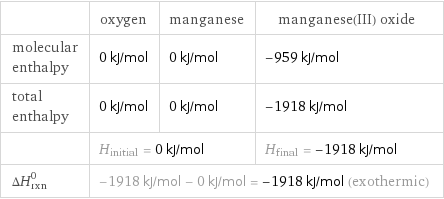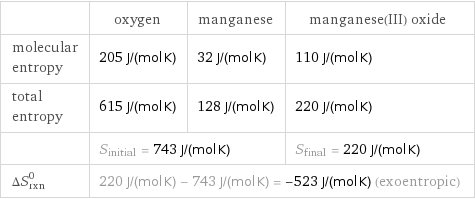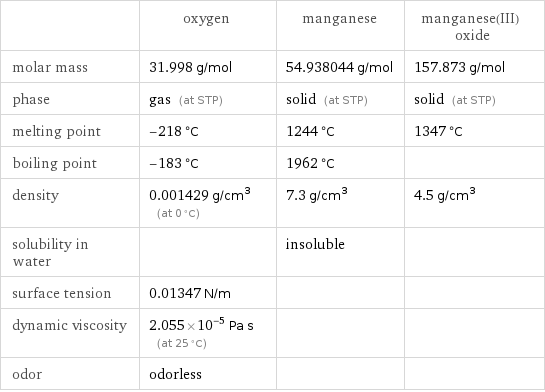Input interpretation

O_2 oxygen + Mn manganese ⟶ Mn_2O_3 manganese(III) oxide
Balanced equation

Balance the chemical equation algebraically: O_2 + Mn ⟶ Mn_2O_3 Add stoichiometric coefficients, c_i, to the reactants and products: c_1 O_2 + c_2 Mn ⟶ c_3 Mn_2O_3 Set the number of atoms in the reactants equal to the number of atoms in the products for O and Mn: O: | 2 c_1 = 3 c_3 Mn: | c_2 = 2 c_3 Since the coefficients are relative quantities and underdetermined, choose a coefficient to set arbitrarily. To keep the coefficients small, the arbitrary value is ordinarily one. For instance, set c_3 = 1 and solve the system of equations for the remaining coefficients: c_1 = 3/2 c_2 = 2 c_3 = 1 Multiply by the least common denominator, 2, to eliminate fractional coefficients: c_1 = 3 c_2 = 4 c_3 = 2 Substitute the coefficients into the chemical reaction to obtain the balanced equation: Answer: | | 3 O_2 + 4 Mn ⟶ 2 Mn_2O_3
Structures

+ ⟶
Names

oxygen + manganese ⟶ manganese(III) oxide
Reaction thermodynamics
Enthalpy

| oxygen | manganese | manganese(III) oxide molecular enthalpy | 0 kJ/mol | 0 kJ/mol | -959 kJ/mol total enthalpy | 0 kJ/mol | 0 kJ/mol | -1918 kJ/mol | H_initial = 0 kJ/mol | | H_final = -1918 kJ/mol ΔH_rxn^0 | -1918 kJ/mol - 0 kJ/mol = -1918 kJ/mol (exothermic) | |
Entropy

| oxygen | manganese | manganese(III) oxide molecular entropy | 205 J/(mol K) | 32 J/(mol K) | 110 J/(mol K) total entropy | 615 J/(mol K) | 128 J/(mol K) | 220 J/(mol K) | S_initial = 743 J/(mol K) | | S_final = 220 J/(mol K) ΔS_rxn^0 | 220 J/(mol K) - 743 J/(mol K) = -523 J/(mol K) (exoentropic) | |
Equilibrium constant
![Construct the equilibrium constant, K, expression for: O_2 + Mn ⟶ Mn_2O_3 Plan: • Balance the chemical equation. • Determine the stoichiometric numbers. • Assemble the activity expression for each chemical species. • Use the activity expressions to build the equilibrium constant expression. Write the balanced chemical equation: 3 O_2 + 4 Mn ⟶ 2 Mn_2O_3 Assign stoichiometric numbers, ν_i, using the stoichiometric coefficients, c_i, from the balanced chemical equation in the following manner: ν_i = -c_i for reactants and ν_i = c_i for products: chemical species | c_i | ν_i O_2 | 3 | -3 Mn | 4 | -4 Mn_2O_3 | 2 | 2 Assemble the activity expressions accounting for the state of matter and ν_i: chemical species | c_i | ν_i | activity expression O_2 | 3 | -3 | ([O2])^(-3) Mn | 4 | -4 | ([Mn])^(-4) Mn_2O_3 | 2 | 2 | ([Mn2O3])^2 The equilibrium constant symbol in the concentration basis is: K_c Mulitply the activity expressions to arrive at the K_c expression: Answer: | | K_c = ([O2])^(-3) ([Mn])^(-4) ([Mn2O3])^2 = ([Mn2O3])^2/(([O2])^3 ([Mn])^4)](../image_source/ffaac9b5b1475060f7cbb57aaaea7616.png)
Construct the equilibrium constant, K, expression for: O_2 + Mn ⟶ Mn_2O_3 Plan: • Balance the chemical equation. • Determine the stoichiometric numbers. • Assemble the activity expression for each chemical species. • Use the activity expressions to build the equilibrium constant expression. Write the balanced chemical equation: 3 O_2 + 4 Mn ⟶ 2 Mn_2O_3 Assign stoichiometric numbers, ν_i, using the stoichiometric coefficients, c_i, from the balanced chemical equation in the following manner: ν_i = -c_i for reactants and ν_i = c_i for products: chemical species | c_i | ν_i O_2 | 3 | -3 Mn | 4 | -4 Mn_2O_3 | 2 | 2 Assemble the activity expressions accounting for the state of matter and ν_i: chemical species | c_i | ν_i | activity expression O_2 | 3 | -3 | ([O2])^(-3) Mn | 4 | -4 | ([Mn])^(-4) Mn_2O_3 | 2 | 2 | ([Mn2O3])^2 The equilibrium constant symbol in the concentration basis is: K_c Mulitply the activity expressions to arrive at the K_c expression: Answer: | | K_c = ([O2])^(-3) ([Mn])^(-4) ([Mn2O3])^2 = ([Mn2O3])^2/(([O2])^3 ([Mn])^4)
Rate of reaction
![Construct the rate of reaction expression for: O_2 + Mn ⟶ Mn_2O_3 Plan: • Balance the chemical equation. • Determine the stoichiometric numbers. • Assemble the rate term for each chemical species. • Write the rate of reaction expression. Write the balanced chemical equation: 3 O_2 + 4 Mn ⟶ 2 Mn_2O_3 Assign stoichiometric numbers, ν_i, using the stoichiometric coefficients, c_i, from the balanced chemical equation in the following manner: ν_i = -c_i for reactants and ν_i = c_i for products: chemical species | c_i | ν_i O_2 | 3 | -3 Mn | 4 | -4 Mn_2O_3 | 2 | 2 The rate term for each chemical species, B_i, is 1/ν_i(Δ[B_i])/(Δt) where [B_i] is the amount concentration and t is time: chemical species | c_i | ν_i | rate term O_2 | 3 | -3 | -1/3 (Δ[O2])/(Δt) Mn | 4 | -4 | -1/4 (Δ[Mn])/(Δt) Mn_2O_3 | 2 | 2 | 1/2 (Δ[Mn2O3])/(Δt) (for infinitesimal rate of change, replace Δ with d) Set the rate terms equal to each other to arrive at the rate expression: Answer: | | rate = -1/3 (Δ[O2])/(Δt) = -1/4 (Δ[Mn])/(Δt) = 1/2 (Δ[Mn2O3])/(Δt) (assuming constant volume and no accumulation of intermediates or side products)](../image_source/2bee37e8c079ebf52fa521294eb08974.png)
Construct the rate of reaction expression for: O_2 + Mn ⟶ Mn_2O_3 Plan: • Balance the chemical equation. • Determine the stoichiometric numbers. • Assemble the rate term for each chemical species. • Write the rate of reaction expression. Write the balanced chemical equation: 3 O_2 + 4 Mn ⟶ 2 Mn_2O_3 Assign stoichiometric numbers, ν_i, using the stoichiometric coefficients, c_i, from the balanced chemical equation in the following manner: ν_i = -c_i for reactants and ν_i = c_i for products: chemical species | c_i | ν_i O_2 | 3 | -3 Mn | 4 | -4 Mn_2O_3 | 2 | 2 The rate term for each chemical species, B_i, is 1/ν_i(Δ[B_i])/(Δt) where [B_i] is the amount concentration and t is time: chemical species | c_i | ν_i | rate term O_2 | 3 | -3 | -1/3 (Δ[O2])/(Δt) Mn | 4 | -4 | -1/4 (Δ[Mn])/(Δt) Mn_2O_3 | 2 | 2 | 1/2 (Δ[Mn2O3])/(Δt) (for infinitesimal rate of change, replace Δ with d) Set the rate terms equal to each other to arrive at the rate expression: Answer: | | rate = -1/3 (Δ[O2])/(Δt) = -1/4 (Δ[Mn])/(Δt) = 1/2 (Δ[Mn2O3])/(Δt) (assuming constant volume and no accumulation of intermediates or side products)
Chemical names and formulas

| oxygen | manganese | manganese(III) oxide formula | O_2 | Mn | Mn_2O_3 name | oxygen | manganese | manganese(III) oxide IUPAC name | molecular oxygen | manganese | oxo-(oxomanganiooxy)manganese
Substance properties

| oxygen | manganese | manganese(III) oxide molar mass | 31.998 g/mol | 54.938044 g/mol | 157.873 g/mol phase | gas (at STP) | solid (at STP) | solid (at STP) melting point | -218 °C | 1244 °C | 1347 °C boiling point | -183 °C | 1962 °C | density | 0.001429 g/cm^3 (at 0 °C) | 7.3 g/cm^3 | 4.5 g/cm^3 solubility in water | | insoluble | surface tension | 0.01347 N/m | | dynamic viscosity | 2.055×10^-5 Pa s (at 25 °C) | | odor | odorless | |
Units
